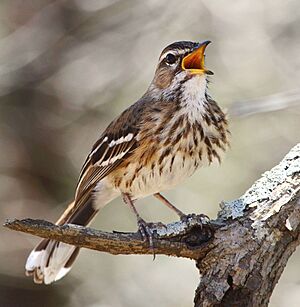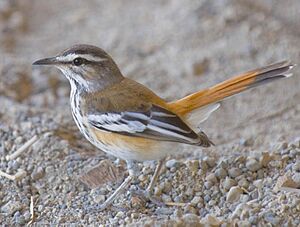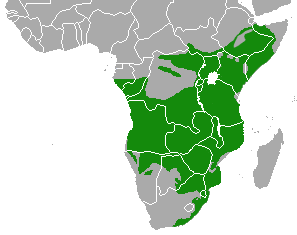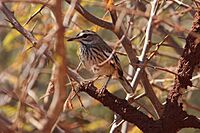White-browed scrub robin facts for kids
Quick facts for kids White-browed scrub robin |
|
|---|---|
 |
|
 |
|
| C. l. pectoralis (above) in South Africa and C. l. zambesiana (below), Tanzania | |
| Conservation status | |
| Scientific classification | |
| Genus: |
Cercotrichas
|
| Species: |
leucophrys
|
 |
|
| resident range | |
| Synonyms | |
|
Erythropygia zambesiana |
|
The white-browed scrub robin (Cercotrichas leucophrys) is a small bird found in sub-Saharan Africa. It is also known as the red-backed scrub-robin. This bird is part of the Muscicapidae family, which includes flycatchers and robins. You can often hear its song in the African bush, especially in East and southern Africa. A cool thing about this bird is how it flicks its tail!
Contents
About the White-Browed Scrub Robin
The white-browed scrub robin was first described in 1817 by a person named Louis Pierre Vieillot. Its scientific name, leucophrys, comes from ancient Greek words. Leukos means "white" and ǒphrys means "eyebrow". This name perfectly describes the bird's distinct white stripe above its eye.
Types of White-Browed Scrub Robins
There are many different types, or subspecies, of the white-browed scrub robin. Scientists recognize about 9 to 12 of these subspecies. They are generally divided into two main groups:
- White-winged group: These birds usually live in dry, arid areas.
- Red-backed group: These birds prefer wetter, more moist places.
Even though they are different, some of these groups can mix where their homes meet.
White-winged Group Subspecies
- C. l. leucoptera: Found in dry woodlands from South Sudan to the Horn of Africa.
- C. l. eluta: Lives in dry woodlands from Ethiopia to southern Somalia.
- C. l. vulpina: Found in the dry woodlands of eastern Kenya and Tanzania.
Red-backed Group Subspecies
- C. l. brunneiceps: Lives along the Rift Valley and in the Crater Highlands.
- C. l. sclateri: Found in the Mbulu Highlands and Tarangire National Park in Tanzania.
- C. l. zambesiana: Lives west of the Rift Valley and near the African Great Lakes.
- C. l. munda: Found from southern Gabon to central Angola.
- C. l. ovamboensis: Lives in parts of Angola, Namibia, Zambia, and Zimbabwe.
- C. l. leucophrys: Found in southern Zimbabwe, Mozambique, and southern South Africa.
Some scientists also identify a few more subspecies within the southern African region:
- C. l. pectoralis: Found in southern Zimbabwe, eastern Botswana, and northern South Africa.
- C. l. simulator: Lives in southern Mozambique and Eswatini.
- C. l. streptitans: Found in KwaZulu-Natal, South Africa.
What They Look Like
The white-browed scrub robin is a medium-sized bird, about 14 to 16.5 centimeters long. Both male and female birds look very similar.
They have a clear, pale stripe above their eyes, which looks like an eyebrow. Their head can be warm brown, olive brown, or grayish brown. Their wings are dark but have clear markings. The tips of their wing feathers are always white.
The amount of streaking on their chest can vary a lot between different subspecies. Their chest and sides often have a tawny (orangey-brown) color. The back of the bird can be brownish, hazel, or even reddish, depending on where they live. Their tail is usually grayish brown to reddish, with a black band near the end and white tips. Young birds have a mottled look but already have the adult tail pattern.
Where They Live
You can find the white-browed scrub robin in many countries across Africa. These include Angola, Botswana, Burundi, Republic of the Congo, DRC, Djibouti, Eswatini, Ethiopia, Gabon, Kenya, Malawi, Mozambique, Namibia, Rwanda, Somalia, South Africa, South Sudan, Tanzania, Uganda, Zambia, and Zimbabwe.
They live in many different types of places, from tropical to temperate areas. They like woodlands or savannas that have good cover, like open scrub or thick bushes. They are usually found in areas with grass, which is important for their nests. In some high areas, they only live up to about 1,400 to 1,500 meters.
Behavior
These birds usually stay in one place, except for those in the far south. They are active but can be quite shy. They often sing from hidden spots inside bushes. When they look for food, they hop around on the ground.
Like some other scrub robins, they often flick and fan their tails. They might also droop their wings. If they sense danger, they make a sharp "skirr" or "skee-ip" sound. Their song is loud and varied, often repeating sounds many times. Scientists believe that the songs of different subspecies might sound a bit different. The 'white-winged' group's songs are thought to be higher-pitched. They mostly eat insects, especially termites and ants.
Reproduction
White-browed scrub robins form pairs and nest alone. They usually build their nests from early to midsummer. The female bird builds the nest using dry grass. She places it low to the ground, about 10 to 20 centimeters high, inside a clump of grass.
The female usually lays three cream-colored eggs. These eggs are about 20 x 14 millimeters and have brown and purple spots around the wider end. Only the female bird sits on the eggs to keep them warm. Once the chicks hatch, both parents help to raise them. Sometimes, other birds like cuckoos lay their eggs in the scrub robin's nest, and the scrub robins end up raising the cuckoo chicks.



